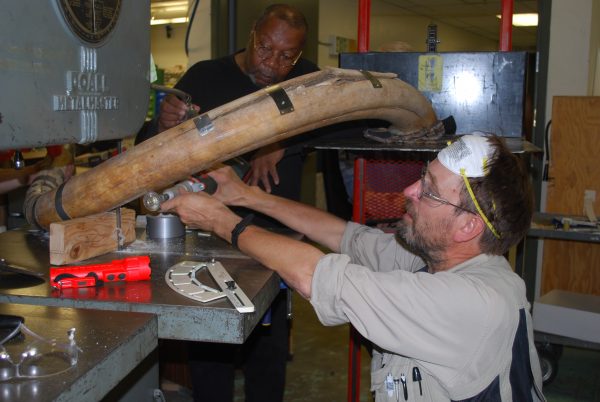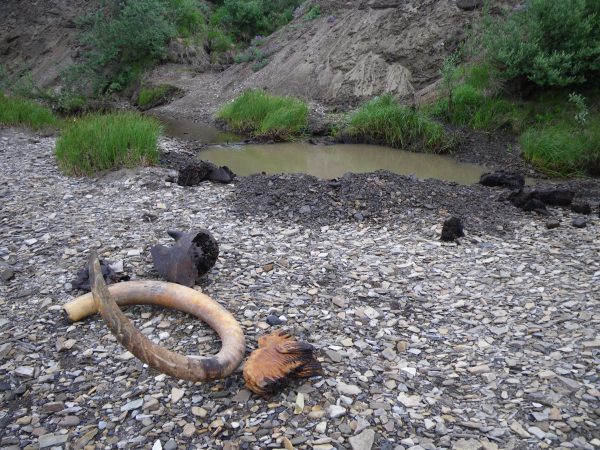Slicing a 20,000-year-old mammoth tusk
September 1, 2017
Ned Rozell
907-474-7468

In his job as a university machinist, Dale Pomraning has built and fixed earthquake detectors and aurora rockets. But recently he worked on his first object that was once part of a living creature. He and others sliced a 6-foot, 100-pound wooly mammoth tusk lengthwise, sort of like a salmon fillet.
Seven people spent six hours wrestling the tusk into place for the precision cut.
“We’ve got a great big corkscrew we’re trying to run though the bandsaw,” said Pomraning, who works in ĐÔÓűÉç Geophysical Institute's machine shop. “It was an extremely awkward job.”
Three scientists enlisted Pomraning and his supervisor, Greg Shipman, for the job. Dan Mann, Pam Groves and Mat Wooller wanted the tusk split down the middle in order to tell, among other things, how far this northern mammoth roamed.
“Nobody’s taken a tusk and split it lengthwise,” said Wooller, who runs ĐÔÓűÉç’s Alaska Stable Isotope Facility. “Greg and Dale were way into it.”
Mammoth tusks grew like stacks of waffle cones, extending outward a few inches each year. After they have the flattened side of the tusk polished and perhaps stained, the scientists should be able to see chevrons that correspond with individual years in the mammoth’s life.
And who was this mammoth? It last walked in the ancient basin of the Kikiakrorak River, which flows into the Colville River on Alaska’s North Slope. In 2010, ĐÔÓűÉç’s Mann and Groves dug it out of the riverbed in two days, with help from Ben Gaglioti, Mike Kunz and a helicopter mechanic who didn’t mind standing in waist-deep water wearing only his underwear. Officials with the federal Bureau of Land Management allowed them to recover the tusk and use it for research.
The tusk is in fine shape and radiocarbon dated to the Last Glacial Maximum. By the curvature and size of this tusk, Groves thinks it belonged to a smaller male. The mammoth was alive 20,000 years ago, when glaciers held much more of the world's freshwater on land. Sea level was more than 300 feet lower than today, making the Bering Land Bridge a wide, grassy passage from North America to Asia.

The tusk may hold the answer to how far this mammoth moved during its 50 or 60 years of life. The scientists will remove aspirin-size cores from along the flat centerline of the tusk. They will analyze them for ancient traces of carbon, nitrogen and strontium. The carbon and nitrogen isotopes from the ivory will tell them what the Kik River mammoth ate at different times of the year and at varying stages of its life.
Changes in strontium isotope concentrations in the ivory will provide clues about where this mammoth lived from year to year. Streams and rivers carry unique signatures of strontium because of the chemical composition of the bedrock they flow over. Animals pick up differing amounts of strontium from the water they drink and the plants they eat. Some of this strontium ends up in their bones, teeth and tusks.
“Mammoths might have eaten between 100 and 200 pounds of grass and sedge every day,” Mann said. “Today’s elephants feed for 18 to 20 hours every day. Where did mammoths find enough food? Were they like caribou, migrating between summer and winter ranges?”
“Mammoths might have been specialists at picking up and moving,” Groves said. “If the climate got hard they could have wandered across to Siberia looking for greener pastures.”
If the unique ivory-cutting technique gives some new answers, the researchers may again enlist Shipman and Pomraning to cut tusks with the Geophysical Institute’s bandsaw.
“It’s very different to have a job that makes the shop smell like the dentist’s when you have your teeth drilled,” Pomraning said.
Since the late 1970s, ĐÔÓűÉç' Geophysical Institute has provided this column free in cooperation with the ĐÔÓűÉç research community. Ned Rozell is a science writer for the Geophysical Institute.


